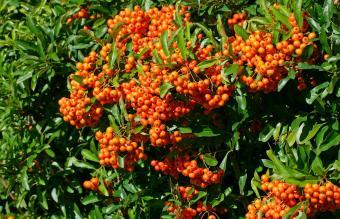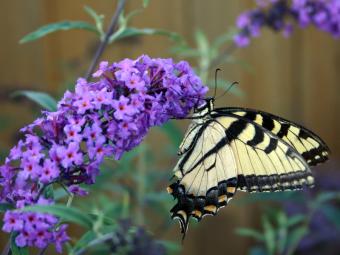
Many of the best shrubs you can plant in the shade can also survive in full sun. However, there are some shrubs that prefer deep shade and can offer you an ideal solution for your yard and garden.
Best Shrubs for Shade Gardens and Yards
A deep shade area in your yard or garden requires plants that can endure the entire day being in the shade. There may be different levels of shade throughout the day, but the area is typically underneath a thick tree canopy or in the shadow of a building, home, hill, or mountain.
1. Japanese Andromeda
Japanese Andromeda (pieris Katsura) is a four-season shrub since this evergreen changes from green to red in the spring and summer. The green foliage is a dark green during the winter months. When selecting pieris Katsura for your garden or yard, keep in mind that is it a slow-growing shrub and plan your landscaping accordingly.
Spring Blooms and Red Leaves
In early spring, the shrub produces pink tinged white flowers that are bell shaped and are similar in appearance to lily of the valley. Once the flowers are spent, the leaves turn a deep rich burgundy hue for a short time before transforming into dark green, glossy leaves. The leaves cluster at the tip of the branch. New growth is burgundy until it morphs green. The shrub has a rounded shape with densely packed leaves.
- Zones: 5-7
- Height: 5'-6'
- Spread: 5'-6'
- Shade: Partial to deep
- Level of care: Easy
- Soil: Moist (average), well-drained, mulch in spring
- Water: Moderate, high tolerance to droughts
- Prune: ASAP after blooming finished
- Tips: Winter winds can damage them.

2. Mahonia
Mahonia has over 70 species and makes a fantastic shade shrub. Discovered by the Lewis and Clark expedition, it was named for plant collection steward, horticulturist Bernard McMahon. The blue to blue-green pinnate leaves resemble holly leaves. In spring, clusters of yellow flower spires emerge followed by dusty dark blue/purple edible berries that are high in vitamin C.
Quick Facts
Birds and butterflies love mahonia shrubs.
- Zones: 6-9
- Height: 3'-7'
- Spread: 5'
- Shade: Deep shades, tolerates partial
- Level of care: Easy
- Soil: Well-drained
- Water: Low to moderate, high tolerance to droughts
- Prune: Immediately after blooming
- Tips: Some species, such as Mahonia aquifolium, or Oregon Grape, are considered an invasive plant in some areas. Check species with local Agriculture Extension before planting for invasive regional listing.

3. Rhododendron
Rhododendron shrubs is often called the rose tree. There are more than 900 species with some being evergreen and other deciduous. Most rhododendrons have amazing large flowers in white, salmon, pinks, yellow, crimson red, deep purple, apricot, blue, and lavender. Ideal location is underneath tall tree canopies.
- Zones: 5-8
- Height: 3' - 6', some varieties 10'+
- Spread: 3'-7'
- Shade: Partial, tolerates morning light
- Level of care: Easy
- Soil: Humus rich soil, well-drained
- Water: Water if below 1" weekly rainfall
- Prune: After blooms spent
- Tips: Mulch to protect shallow root system, leave 4"-6" diameter around the trunk mulch-free.

4. Leatherleaf Arrowwood
Leatherleaf arrowwood (viburnum rhytidophyllum) is an evergreen Asian shrub makes a great ornamental. The leaves are apex pointed with a leathery blue-green appearance with light green undersides. Creamy white flowers emerge in mid- to late spring and continue through June. Blue or red colored berries develop after the blooms and turn black in the fall.
- Zones: 4-8
- Height: 6'-10'
- Spread: 6'-10'
- Shade: Deep shade, tolerates partial
- Level of care: Easy
- Soil: Average, humus, well drained
- Water: Medium
- Prune: After flowering completed
- Tips: Blooms are fragrant.

5. Aucuba
Aucuba japonica is also known as Japanese laurel and spotted laurel. The plant requires a male and female planted close to each other in order to produce red berries in the winter. The berries are poisonous! This plant can be planted along coastal regions since it can endure salt air.
- Height: 6'-10', can reach 15'
- Spread: 5'-9'
- Shade: Deep shade and partial
- Level of care: easy
- Soil: Rich loam, tolerates clay
- Water: Average, drought resistant
- Prune: Spring
- Tips: Can be used for hedges and other screening foliage

6. Firethorn
Firethorn (Pyracantha) is a fast-growing evergreen shrub that is used as a hedge or grown on a trellis for an ornamental shrub. It makes an excellent privacy barrier since it has very proficient, long, sharp thorns. The drawing card for this shrub is its annual growth of two feet. Firethorn produces an abundance of small white flowers in clusters. Red-orange fruits called pomes follow the flowers. Birds enjoy these through the winter. In some areas of the United States, the pyracantha is considered an invasive plant, so check with your Agricultural Extension before planting.
- Zones: 6-9
- Height: 18'
- Spread: 6'-18'
- Shade: Partial
- Level of care: Easy
- Soil: Most types
- Water: Keep soil moist
- Prune: Lightly prune in spring and fall
- Tips: Overgrown plants can be cut back to trunk.

7. Camellia
Camellia sinensis is a popular shade plant and prized for its mid-fall to early winter blooms. It is revered for the tea that's made from its harvested leaves. This plant has beautiful fragrant white or pink flowers. Camellias thrive better when planted underneath tall tree canopies.
- Zones: 7-10
- Height: 4'-5'
- Spread: 4'-5'
- Shade: Partial, morning light preferred
- Level of care: Easy
- Soil: Prefers slightly acidic
- Water: Moderate
- Prune: After blooming, trim lower branches for upright growth and top spindly growth
- Tips: Camellias do well when planted in the north portion of your yard or garden, due to shade.

8. Japanese Skimmia
The Japanese skimmia (Skimmia japonica) is a fragrant broadleaf evergreen shade shrub. It produces cream white blooms in late spring followed by white or red fruits. You'll need to plant a male and female closely together for pollination.
- Zones: 6-8
- Height: 3'-4'
- Spread: 4'-5'
- Shade: Deep, partial
- Level of care: Easy
- Soil: Humus, well-drained
- Water: Average
- Prune: Winter
- Tips: Ideal to use for hedges

Deciding on the Best Shrubs for Shade
The best shrubs for shade pantings can often tolerate a mixture of lighting conditions. Decide on the texture, fruiting and flowering you want for your yard or garden before selecting shade plants.







